3m Watch
September 10, 2024
ANTIMICROBIAL STEWARDSHIP
Video
A Public Health Dialogue on Antibiotic Resistance Surveillance
Infection prevention culture is one of the biggest needs in public health right now. Hospitals are at the forefront of antibiotic resistance surveillance because they're the first to encounter a patient with an infection or colonized with a drug-resistant organism. Watch as leading AMR experts discuss the latest in Antibiotic Resistance Surveillance to identify outbreaks before they happen, track trends, and even help in vaccine development.
Alessandro Rossi, Ph.D.: “Hospitals are at the forefront of antibiotic resistance surveillance because they're the first to encounter patients with an infection or colonized with a drug-resistant organism.”
Jennifer L. Dale Ph.D.: “We're trying to identify outbreaks before they happen or any sort of primarily carbapenemase-producing organisms before there can be any sort of large-scale transmission event so what we obtain our epidemiologists are able to track trends and even help in some vaccine development or really look for transmission events to prevent anything from getting out of one healthcare sitting into the next healthcare setting.”
Alessandro Rossi, Ph.D.: “I see more of a gap at small, longterm care facilities level where this infection prevention culture is just not there.”
Philip Dykema: “One of the biggest needs in public health right now when it comes to these carbapenemase-producing organisms is that there are five major genes that are contributing factors towards it as well as in one of them the oxypenase-producing organisms those have quite a few alleles and so what we have are PCR situations where you have a single well and you have that's going to go for one gene you go to the next one it's another gene and so you have this array of wells and it's all one organism to be able to do a complex multiplex PCR where it's one well multiple set of genes in that well is uh really crucial to us, right now so as to reduce the amount of labor and cost.”
Jennifer L. Dale Ph.D.: “We have a very robust collaboration with our clinical partners in order to do surveillance testing and it really requires a relationship of communication between the hospital labs to address what kind of surveillance testing we want to perform and how to get those samples to us at the public health lab for testing.”
Philip Dykema: “Our ability to detect these organisms is based mainly on PCR and so we have to do the extraction of the nucleic acids out of the organisms and then run various PCR platforms. We like platforms that are self-contained in other words the platform is a plug-and-play cartridge in which the detection can occur there without having to do the extractions and then set up the PCR, which is time laborious I mean that takes anywhere from 4 to 5 hours to complete on just one organism. If you have the cartridge you just simply insert it and place it in the instrument and you can walk away and pay attention to other work that you have to do.”
Alessandro Rossi, Ph.D.: “What we do is important because by preventing the spread of very difficult-to-treat pathogens, you prevent unnecessary deaths and morbidity as well as economic loss.”
Read Next
MORE







